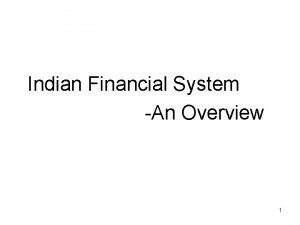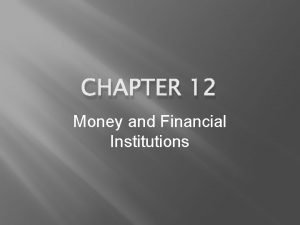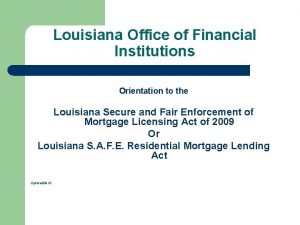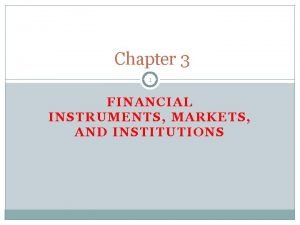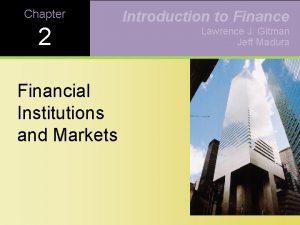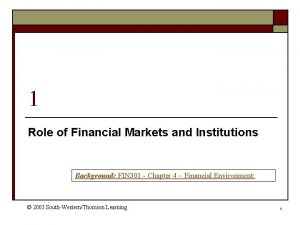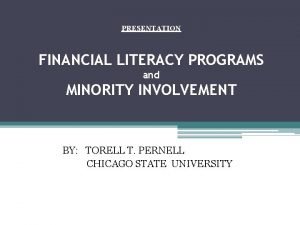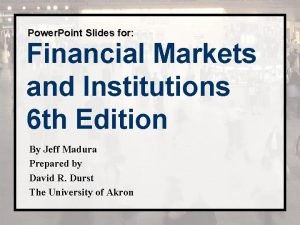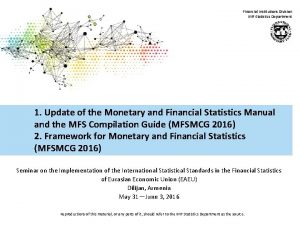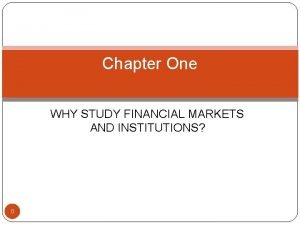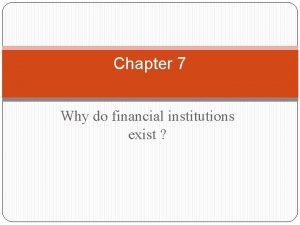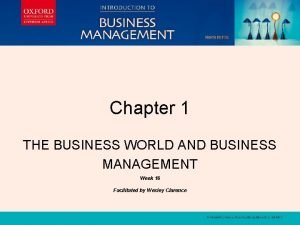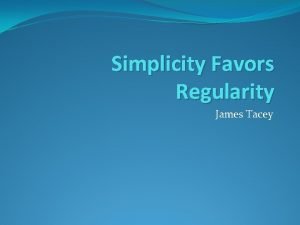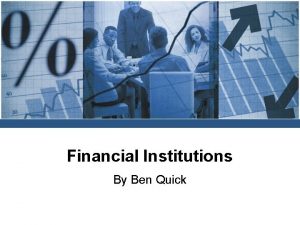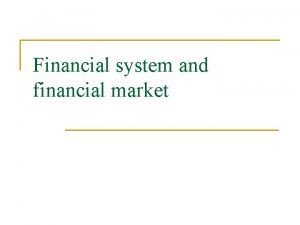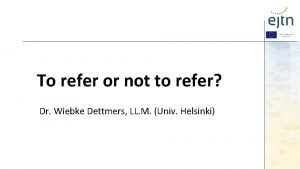Financial Market Institutions for simplicity we refer to










































- Slides: 42

Financial Market & Institutions

� for simplicity, we refer to these as banks � are financial intermediaries that accept deposits from individuals and institutions and make loans. � The study of money and banking focuses special attention on this group of financial institutions, because they are involved in the creation of deposits, an important component of the money supply. � These institutions include commercial banks and the so-called thrift institutions (thrifts): savings and loan associations, mutual savings banks, and credit unions. Depository institutions

� � � These financial intermediaries raise funds primarily by issuing checkable deposits (deposits on which checks can be written), savings deposits (deposits that are payable on demand but do not allow their owner to write checks), time deposits (deposits with fixed terms to maturity). They then use these funds to make commercial, consumer, and mortgage loans and to buy government securities and municipal bonds. As a group, they are the largest financial intermediary and have the most diversified portfolios (collections) of assets. Commercial Banks.

� These depository institutions obtain funds primarily through savings deposits (often called shares) and time and checkable deposits. � In the past, these institutions were constrained in their activities and mostly made mortgage loans for residential housing. � Over time, these restrictions have been loosened so that the distinction between these depository institutions and commercial banks has blurred. These intermediaries have become more alike and are now more competitive with each other. Savings and Loan Associations (S&Ls) and Mutual Savings Banks.

� These financial institutions are very small cooperative lending institutions organized around a particular group: union members, employees of a particular firm, and so forth. They acquire funds from deposits called shares and primarily make consumer loans. Credit Unions.

� Such as insurance companies and pension funds, are financial intermediaries that acquire funds at periodic intervals on a contractual basis. � Because they can predict with reasonable accuracy how much they will have to pay out in benefits in the coming years, they do not have to worry as much as depository institutions about losing funds. � As a result, the liquidity of assets is not as important for them as it is for depository institutions, and they tend to invest their funds primarily in long-term securities such as corporate bonds, stocks, and mortgages. Contractual savings institutions

� Life insurance companies insure people against financial hazards following a death and sell annuities (annual income payments upon retirement). � They acquire funds from the premiums that people pay to keep their policies in force and use them mainly to buy corporate bonds and mortgages. They also purchase stocks, but are restricted in the amount that they can hold. � They are among the largest of the contractual savings institutions. Life Insurance Companies.

� These companies insure their policyholders against loss from theft, fire, and accidents. � They are very much like life insurance companies, receiving funds through premiums for their policies, but they have a greater possibility of loss of funds if major disasters occur. � For this reason, they use their funds to buy more liquid assets than life insurance companies do. � Their largest holding of assets is municipal bonds; they also hold corporate bonds and stocks and government securities. Fire and Casualty Insurance Companies.

� � Pension funds and state and local retirement funds provide retirement income in the form of annuities to employees who are covered by a pension plan. Funds are acquired by contributions from employers or from employees, who either have a contribution automatically deducted from their paychecks or contribute voluntarily. The largest asset holdings of pension funds are corporate bonds and stocks. The establishment of pension funds has been actively encouraged by the federal government, both through legislation requiring pension plans and through tax incentives to encourage contributions. Pension Funds and Government Retirement Funds.

� This category of financial intermediaries includes finance companies, mutual funds, money market mutual funds �Finance Companies. Finance companies raise funds by selling commercial paper (a short-term debt instrument) and by issuing stocks and bonds. They lend these funds to consumers, who make purchases of such items as furniture, automobiles, and home improvements, and to small businesses. � Some finance companies are organized by a parent corporation to help sell its product. For example, Ford Motor Credit Company makes loans to consumers who purchase Ford automobiles. Investment Intermediaries

� � These financial intermediaries acquire funds by selling shares to many individuals and use the proceeds to purchase diversified portfolios of stocks and bonds. Mutual funds allow shareholders to pool their resources so that they can take advantage of lower transaction costs when buying large blocks of stocks or bonds. In addition, mutual funds allow shareholders to hold more diversified portfolios than they otherwise would. Shareholders can sell (redeem) shares at any time, but the value of these shares will be determined by the value of the mutual fund’s holdings of securities. Because these fluctuate greatly, the value of mutual fund shares will too; therefore, investments in mutual funds can be risky. Mutual Funds.

� � These relatively new financial institutions have the characteristics of a mutual fund but also function to some extent as a depository institution because they offer deposit -type accounts. They sell shares to acquire funds that are then used to buy money market instruments that are both safe and very liquid. The interest on these assets is then paid out to the shareholders. A key feature of these funds is that shareholders can write checks against the value of their shareholdings. In effect, shares in a money market mutual fund function like checking account deposits that pay interest. Money Market Mutual Funds.

� The financial system is among the most heavily regulated sectors economy. � The government regulates financial markets for two main reasons: � To increase the information available to investors and, � to ensure the soundness of the financial system. Regulation of the Financial System

� � Asymmetric information in financial markets means that investors may be subject to adverse selection and moral hazard problems that may hinder the efficient operation of financial markets. Risky firms may be the most eager to sell securities to unwary investors, and the resulting adverse selection problem may keep investors out of financial markets. Furthermore, once an investor has bought a security, thereby lending money to a firm, the borrower may have incentives to engage in risky activities or to commit fraud. The presence of this moral hazard problem may also keep investors away from financial markets. Government regulation can reduce adverse selection and moral hazard problems in financial markets and increase their efficiency by increasing the amount of information available to investors. Increasing Information Available to Investors

� � � As a result of the stock market crash and revelations of widespread fraud in the aftermath, political demands for regulation culminated The SEC requires corporations issuing securities to disclose certain information about their sales, assets, and earnings to the public and restricts trading by the largest stockholders (known as insiders) in the corporation. By requiring disclosure of this information and by discouraging insider trading, which could be used to manipulate security prices, the SEC hopes that investors will be better informed and be protected from some of the abuses in financial markets Cont…

Ensuring the Soundness of Financial Intermediaries � Asymmetric information can also lead to widespread collapse of financial intermediaries, referred to as a financial panic. � Because providers of funds to financial intermediaries may not be able to assess whether the institutions holding their funds are sound, if they have doubts about the overall health of financial intermediaries, they may want to pull their funds out of both sound and unsound institutions. � The possible outcome is a financial panic that produces large losses for the public and causes serious damage to the economy. � To protect the public and the economy from financial panics, the government has implemented regulations.

� State banking have created very tight regulations governing who is allowed to set up a financial intermediary. � Individuals or groups that want to establish a financial intermediary, such as a bank or an insurance company, must obtain a charter from the state or the federal government. Only if they are upstanding citizens with impeccable credentials and a large amount of initial funds will they be given a charter. Restrictions on Entry.

Disclosure. � There are stringent reporting requirements for financial intermediaries. � Their book keeping must follow certain strict principles, their books are subject to periodic inspection, and they must make certain information available to the public.

Restrictions on Assets and Activities. � There are restrictions on what financial intermediaries are allowed to do and what assets they can hold. � Before you put your funds into a bank or some other such institution, you would want to know that your funds are safe and that the bank or other financial intermediary will be able to meet its obligations to you. � One way of doing this is to restrict the financial intermediary from engaging in certain risky activities. Legislation passed to separate commercial banking from the securities industry so that banks could not engage in risky ventures associated with this industry.

Cont… � Another way is to restrict financial intermediaries from holding certain risky assets, or at least from holding a greater quantity of these risky assets than is prudent. � The government can insure people’s deposits so that they do not suffer any financial loss if the financial intermediary that holds these deposits should fail.

Limits on Competition. � unbridled competition among financial intermediaries promotes failures that will harm the public. � Although the evidence that competition does this is extremely weak, it has not stopped the state and federal governments from imposing many restrictive regulations. � First are the restrictions on the opening of additional locations (branches).

Restrictions on Interest Rates. � Competition has also been inhibited by regulations that impose restrictions on interest rates that can be paid on deposits. � banks were prohibited from paying interest on checking accounts. � Federal Reserve System has the power to set maximum interest rates that banks could pay on savings deposits. � These regulations were instituted because of the widespread belief that unrestricted interest-rate competition helped encourage bank failures

Money Market Instruments � Treasury Bills. These short-term debt instruments of the government are issued in 3 -, 6 -, and 12 -month maturities to finance the federal government. � They pay a set amount at maturity and have no interest payments, but they effectively pay interest by initially selling at a discount, that is, at a price lower than the set amount paid at maturity. For instance, you might pay $9, 000 in May 2004 for a one year Treasury Bill that can be redeemed in May 2005 for $10, 000. � Treasury bills are the most liquid of all the money market instruments, because they are the most actively traded.

T-Bills Cont… � They are also the safest of all money market instruments, because there is almost no possibility of default, a situation in which the party issuing the debt instrument (the federal government, in this case) is unable to make interest payments or pay off the amount owed when the instrument matures. � The federal government is always able to meet its debt obligations, because it can raise taxes or issue currency(paper money or coins) to pay off its debts. � Treasury bills are held mainly by banks, although small amounts are held by households, corporations, and other financial intermediaries.

Negotiable Bank Certificates of Deposit �A certificate of deposit (CD) is a debt instrument, sold by a bank to depositors, that pays annual interest of a given amount and at maturity, pays back the original purchase price. � CDs were nonnegotiable; that is, they could not be sold to someone else and could not be redeemed from the bank before maturity without paying a substantial penalty. � In 1961, to make CDs more liquid and more attractive to investors, Citibank introduced the first negotiable CD in large denominations (over $100, 000) that could be resold in a secondary market. �

CDs Cont… � This instrument is now issued by almost all the major commercial banks and has been extremely successful, � CD are an extremely important source of funds for commercial banks, from corporations, money market mutual funds, charitable institutions, and government agencies.

Commercial Paper. �a short-term debt instrument issued by large banks and well-known corporations, � corporations usually borrowed their shortterm funds from banks, � they have come to rely more heavily on selling commercial paper to other financial intermediaries and corporations for their immediate borrowing needs; in other words, they engage in direct finance. � Growth of the commercial paper market has been substantial:

Banker’s Acceptances. � These money market instruments are created in the course of carrying out international trade and have been in use for hundreds of years. �A banker’s acceptance is a bank draft (a promise of payment similar to a check) issued by a firm, payable at some future date, and guaranteed for a fee by the bank that stamps it “accepted. ” � The firm issuing the instrument is required to deposit the required funds into its account to cover the draft. If the firm fails to do so, the bank’s guarantee means that it is obligated to make good on the draft.

Cont… � The advantage to the firm is that the draft is more likely to be accepted when purchasing goods abroad, because the foreign exporter knows that even if the company purchasing the goods goes bankrupt, the bank draft will still be paid off. � These “accepted” drafts are often resold in a secondary market at a discount and are therefore similar in function to Treasury bills. � Typically, they are held by many of the same parties that hold Treasury bills,

Repurchase Agreements. � Repurchase agreements, or repos, are effectively short-term loans (usually with a maturity of less than two weeks) in which Treasury bills serve as collateral, an asset that the lender receives if the borrower does not pay back the loan. � Repos are made as follows: A large corporation, such as General Motors, may have some idle funds in its bank account, say $1 million, which it would like to lend for a week. GM uses this excess $1 million to buy Treasury bills from a bank, which agrees to repurchase them the next week at a price slightly above GM’s purchase price.

Repos Cont… � The effect of this agreement is that GM makes a loan of $1 million to the bank and holds $1 million of the bank’s Treasury bills until the bank repurchases the bills to pay off the loan. � Repurchase agreements are a fairly recent innovation in financial markets. They are now an important source of bank funds

Federal (Fed) Funds. � These are typically overnight loans between banks of their deposits at the Federal Reserve. � The federal funds designation is somewhat confusing, because these loans are not made by the federal government or by the Federal Reserve, but rather by banks to other banks. � One reason why a bank might borrow in the federal funds market is that it might find it does not have enough deposits at the Fed to meet the amount required by regulators. � It can then borrow these deposits from another bank, which transfers them to the borrowing bank using the Fed’s wire transfer system.

� This market is very sensitive to the credit needs of the banks, so the interest rate on these loans, called the federal funds rate, is a closely watched barometer of the tightness of credit market conditions in the banking system and the stance of monetary policy; when it is high, it indicates that the banks are strapped for funds, � whereas are low when it is low, banks’ credit needs

Capital Market Instruments � Capital market instruments are debt and equity instruments with maturities of greater than one year. � They have far wider price fluctuations than money market instruments and are considered to be fairly risky investments.

Stocks. � Stocks are equity claims on the net income and assets of a corporation. � Their value exceeds that of any other type of security in the capital market. The amount of new stock issues in any given year is typically quite small—less than 1% of the total value of shares outstanding. � Individuals hold around half of the value of stocks; the rest are held by pension funds, mutual funds, and insurance companies.

Mortgages. � Mortgages are loans to households or firms to purchase housing, land, or other real structures, where the structure or land itself serves as collateral for the loans. � The mortgage market is the largest debt market in the United States, with the amount of residential mortgages (used to purchase residential housing) outstanding more than quadruple the amount of commercial and farm mortgages. � Savings and loan associations and mutual savings banks have been the primary lenders in the residential mortgage market, although commercial banks have started to enter this market more aggressively. The majority of commercial and farm mortgages are made by commercial banks and life insurance companies.

Mortgages Cont… � The federal government plays an active role in the mortgage that provide funds to the mortgage market by selling bonds and using the proceeds to buy mortgages. An important development in the residential mortgage market in recent years is the mortgagebacked security

Corporate Bonds. These are long-term bonds issued by corporations with very strong credit ratings. The typical corporate bond sends the holder an interest payment twice a year and pays off the face value when the bond matures. � Some corporate bonds, called convertible bonds, have the additional feature of allowing the holder to convert them into a specified number of shares of stock at any time up to the maturity date. � This feature makes these convertible bonds more desirable to prospective purchasers than bonds without it, and allows the corporation to reduce its interest payments, because these bonds can increase in value if the price of the stock appreciates sufficiently. � Because the outstanding amount of both convertible and nonconvertible bonds for any given corporation is small, they are not nearly as liquid as other securities such as U. S. government bonds. �

Bonds Cont… � Although the size of the corporate bond market is substantially smaller than that of the stock market, with the amount of corporate bonds outstanding less than one fourth that of stocks, the volume of new corporate bonds issued each year is substantially greater than the volume of new stock issues. � Thus the behavior of the corporate bond market is probably far more important to a firm’s financing decisions than the behavior of the stock market. The principal buyers of corporate bonds are life insurance companies; pension funds and households are other large holders

Consumer and Bank Commercial Loans. � These are loans to consumers and businesses made principally by banks, but—in the case of consumer loans—also by finance companies. There are often no secondary markets in these loans, which makes them the least liquid of the capital market instruments. However, secondary markets have been rapidly developing

Government Securities & Government Agency Securities. Government Securities. These long-term debt instruments are issued by Treasury to finance the deficits of the federal government. Because they are the most widely traded bonds in the United States (the volume of transactions on average exceeds $100 billion daily), they are the most liquid security traded in the capital market. � They are held by the Federal Reserve, banks, households, and foreigners. � � Government Agency Securities. These are long-term bonds issued by various government agencies to finance such items as mortgages, farm loans, or powergenerating equipment. Many of these securities are guaranteed by the federal government. They function much like government bonds and are held by similar parties.

State and Local Government Bonds � State and local bonds, also called municipal bonds, are long-term debt instruments issued by state and local governments to finance expenditures on schools, roads, and other large programs. An important feature of these bonds is that their interest payments are exempt from federal income tax and generally from state taxes in the issuing state. � Commercial banks, with their high income tax rate, are the biggest buyers of these securities, owning over half the total amount outstanding. � The next biggest group of holders consists of wealthy individuals in high income brackets, followed by insurance companies
 Financial markets and institutions chapter 1
Financial markets and institutions chapter 1 Participants of money market
Participants of money market Functions of financial institutions
Functions of financial institutions Management of financial institutions daibb pdf
Management of financial institutions daibb pdf Regulatory institutions in indian financial system
Regulatory institutions in indian financial system Types of non banking financial institutions
Types of non banking financial institutions Financial markets and institutions - ppt
Financial markets and institutions - ppt Enterprise risk management for financial institutions
Enterprise risk management for financial institutions Chapter 12 money and financial institutions
Chapter 12 money and financial institutions Chapter 12 money and financial institutions
Chapter 12 money and financial institutions Louisiana office of financial institutions
Louisiana office of financial institutions Financial markets instruments and institutions
Financial markets instruments and institutions Madura j. financial markets and institutions
Madura j. financial markets and institutions Finanial institutions accounting
Finanial institutions accounting Role of financial markets and institutions
Role of financial markets and institutions Financial literacy at minority serving institutions
Financial literacy at minority serving institutions What is financial institutions
What is financial institutions Madura j financial markets and institutions
Madura j financial markets and institutions Imf financial statistics
Imf financial statistics Why study financial markets and institutions
Why study financial markets and institutions Why do financial institutions exist
Why do financial institutions exist Market follower
Market follower Segmentation, targeting, positioning
Segmentation, targeting, positioning The need-satisfying institutions of the market economy
The need-satisfying institutions of the market economy Simplicity favours regularity
Simplicity favours regularity Simplicity smart lockers
Simplicity smart lockers Operational simplicity
Operational simplicity Affordability quality simplicity and accountability
Affordability quality simplicity and accountability Simplicity favours regularity
Simplicity favours regularity Simplicity favours regularity
Simplicity favours regularity Attributes of m-commerce
Attributes of m-commerce Greek god of simplicity
Greek god of simplicity Simplicity is prosperity
Simplicity is prosperity Simplicity vs snapper
Simplicity vs snapper Hyperchip
Hyperchip Sigma simplicity
Sigma simplicity Simplicity is a great virtue
Simplicity is a great virtue Download six sigma foundations
Download six sigma foundations Six sigma foundations
Six sigma foundations Formuö
Formuö Typiska novell drag
Typiska novell drag Tack för att ni lyssnade bild
Tack för att ni lyssnade bild Ekologiskt fotavtryck
Ekologiskt fotavtryck




